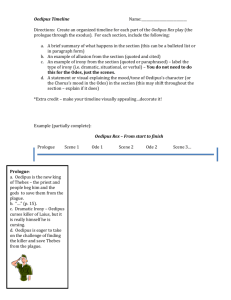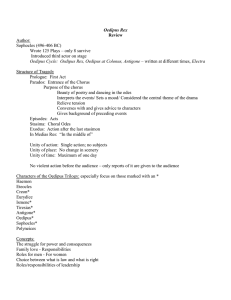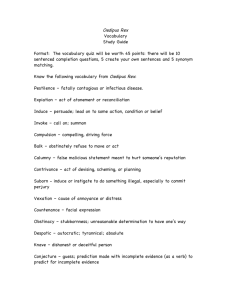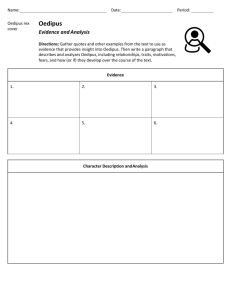Drama and Oedipus
advertisement
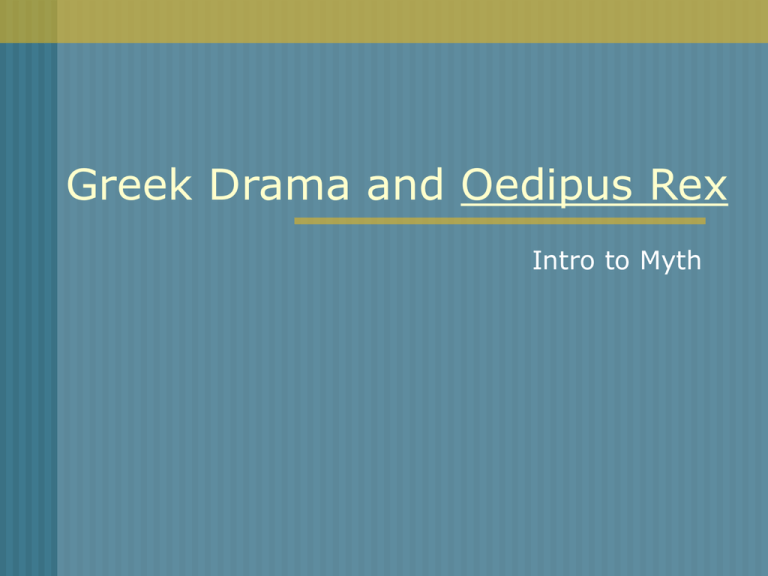
Greek Drama and Oedipus Rex Intro to Myth Greek Theater Greek Theatre: Main components Theatron: literally, the “watching place” Orchestra: literally, the “dancing place” Skene: “scene,” or backdrop Actors 3 Actors, all men Various roles Wore masks Elaborate gestures, “over-acting” Chorus 12-15 men Sang and danced (sort of) the odes One of the chorus may also play a part in the actual play Structure of Greek Drama Prologue The exposition of the play. The Prologue’s purpose is to give background information to situate the conflict. The Odes Serve to separate one scene from another (since there were no curtains in Greek theaters). Also allowed the chorus’s response to the preceding scene. Parts of the Ode Strophe – part of the ode that the chorus chants as it moves from right to left across the stage. Antistrophe – part of the ode chanted as the chorus moves back across the stage from left to right. Parodos (first ode) Choral song chanted by the chorus as they enter the area in front of the stage. First Scene Following the Parodos, the first scene presents the conflict of the play. Paean (follows scene 5) A hymn in praise of a god. Exodos Final scene of the play. Oedipus Rex Aristotle’s Definition of Tragedy Any serious and dignified drama that describes a conflict between the hero (protagonist) and a superior force (antagonist) Reaches a sorrowful conclusion that arouses pity or fear in the audience (catharsis) Recognition and Reversal Recognition is a change from ignorance to knowledge. The new knowledge often identifies an unknown relative or dear one whom the hero should cherish but was about to harm or has just harmed. Reversal is a change of a situation to its opposite. Characteristics of the Tragic Hero The tragic hero: Is not all good or bad Is of the noble class or highly renowned and prosperous Has a tragic flaw Recognizes his error and accepts the consequences Arouses the audience’s pity and fear Sophocles 495-406 B.C.E. Lived during the Peloponnesian War (Athens v. Sparta) Born in Colonus, in Attica 431-404 B.C.E. 429: Writes Oedipus Rex The play shows his anger about his society’s turning away from the gods Plot Summary Oedipus Rex is the story of a king of Thebes upon whom a hereditary curse is placed and who therefore has to suffer the tragic consequences of fate. Oedipus protagonist his name means “swollen-foot” he inspires both pity and fear he is wise, revered by his subjects, and dedicated to the discovery of truth Jocasta (Iocaste) the wife of Oedipus she alternately condemns and upholds the authority of the oracles as best suits the direction of the argument at the moment Symbolic of Sophocles’ culture Laios Former King of Thebes Died before the beginning of the play Oedipus married Laios’ wife and inherited his throne Creon Brother of Jocasta 2nd in command in Thebes Teiresias Blind prophet of Apollo Highly regarded by most Greeks Polybos and Merope King and Queen of Corinth Raised Oedipus Antigone and Ismene Daughters of Oedipus and Jocasta Present in the play, but they do not speak Chorus men of Thebes who honor and respect the king and the gods their odes reveal both a strong attachment to the king as well as grounding in religious culture choral odes bring an additional viewpoint to the play
